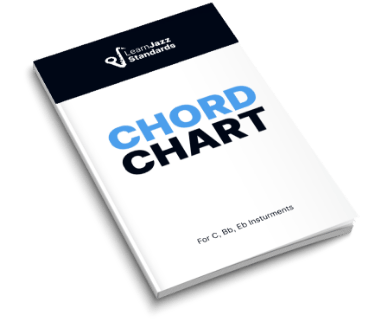Though you might not believe it yet, there are proven steps you can take to seriously learn jazz guitar, improve your knowledge of jazz theory, and elevate your jazz guitar playing skills to new heights.
What appears to be magic radiating from the fingers of jazz guitarists on the stage is actually a finetuned mixture of passion, dedication, time, and jazz guitar best practices shining through on the stage.
The only thing separating you from the jazz player you want to be is time and process. You need time to develop and grow into the jazz guitar player you want to be and a process to get there.
This post will not help you time travel, but it will provide a process to help you achieve meaningful, measurable progress in your jazz guitar playing if you follow it.
- We’ll explore fundamental aspects of guitar playing, jazz theory, and how jazz theory applies to the guitar.
- We’ll explore the basic building blocks of jazz guitar chords, essential scales, and proven methods to develop jazz guitar improvisation skills.
- We’ll also touch upon the mindset you need to cultivate when striving for jazz performance and jazz guitar playing goals
If you find this article helpful and are ready to get serious about mastering jazz guitar, learning jazz standards, and embodying the spirit of a bonafide jazz guitarist, then you should check out the Learn Jazz Standards Inner Circle.
The Inner Circle is designed for musicians looking for a proven process to get from point A to point B with their jazz playing. When you join, you’ll get access to the Jazz Guitar Accelerator course, which was built to help you master jazz on the fretboard.
Ready to trust the process and become the best jazz guitarist you can be? Check out the Inner Circle.
Table of Contents
So You Want To Be a Jazz Guitarist?
Let’s start with a question. What brought you here? What made you want to learn how to play jazz guitar?
99 times out of 100, your answer will have a strong emotional component. It was some emotional connection with the music of one or perhaps many of the jazz greats who first exposed you to the jazz world. For me, it was John Coltrane playing on My Favorite Things.
Despite the allure, many musicians shy away from jazz. They might feel that jazz is too hard or just out of reach. However, despite popular myths and the attitudes of gatekeepers, jazz is accessible.
You can learn jazz no matter what playing level you are at. Whether you are a music student, a casual hobbyist, or a lifelong jazz lover finally ready to learn, jazz is for you.
Even if you only have a half hour a day (or less) to learn it, you’ll see results with the right process. Many people spend hours practicing the wrong stuff or practicing passively, and they waste their precious time.
So, let’s start with the big picture and break down the essential musical skills you need to play jazz guitar.
Essential Music Skills You’ll Need To Play Jazz Guitar
So, let’s break it down into manageable bite-sized categories. What hard music skills do you need to develop to become fluent in jazz guitar?
Music can be broken down into three constituent parts:
- Pitch or what notes you play (both harmony and melody)
- Duration or how long or short the notes you play are in time (rhythm)
- Amplitude or the shape, color, loudness, and softness of the notes you play (feel)
- By strengthening your understanding of pitch, you are strengthening your sense of harmony and melody.
- By strengthening your understanding of duration, you are building a strong rhythmic foundation for learning jazz guitar.
- By strengthening your understanding of amplitude, you are developing a sensitive yet powerful jazz style that will hopefully contain your unique voice.
The best way to understand jazz music and how jazz musicians use pitch, duration, and amplitude to create jazz is to connect directly with the source material.
The Importance of Learning Jazz Standards to Learn How To Play Jazz
As our name might imply, the best way to learn jazz is by learning the many jazz standards that make up the jazz world. These jazz standards contain all the information you need to learn jazz guitar. They are infused with jazz’s harmonic, melodic, and rhythmic features, which make jazz stand out as unique music.
Some of the best jazz guitar lessons you’ll ever have will only require you, your guitar, and your favorite jazz recordings.
Check out 20 easy jazz standards you need to know to start building your tune list.
“Jazz Guitars” vs. Guitars
Next, you might consider what kind of guitar you’ll need to play jazz guitar.
In reality, any guitar can play jazz, but certain types of guitars have become more popular in the genre than others. The type of guitar you use will depend on your playing style, but there isn’t a wrong answer.
Let’s explore the different types of guitars you’ll find in jazz:
Arch-Tops or Hollow-Body Guitars
Traditionally, jazz guitars are hollow-body guitars, which are much closer to acoustic guitars than solid-body guitars like Gibson SGs or Fender Strats. Instead of a sound hole, hollow-bodies guitars usually have f-holes similar to a violin.
Arch-tops, as they are also known, resonate better than solid-body guitars and have a deep, warm tone, but this feature also leads to occasional feedback issues. When you picture jazz guitarists, you are more likely to picture them playing an arch-top.
Semi-Hollow Guitars
Semi-hollow guitars, like the Gibson ES 335, exist in between solid-bodies and hollow-bodies. Tonally, they are a hybrid of their solid and hollow-bodied brethren. They have some resonance but feedback less and are more versatile.
These guitars are a favorite of jazz-fusion players like John Scofield and modern jazz players like Kurt Rosenwinkel, but they work perfectly well for straight-ahead.
Solid-body Guitars
If you ask a random person on the street to picture an electric guitar, they will most likely picture one of these.
Popular in almost every genre, these types of guitars are very versatile and don’t have as many feedback issues. However, they are not as resonate or tonally vibrant as their hollow or semi-hollow compatriots.
Though they aren’t as common in jazz, solid guitars do have their uses in the genre. Telecaster jazz is a real thing! Just ask jazz guitarists Bill Frisell, Mike Stern, or Julian Lage.
Acoustic and Classical Guitars
Steel-string acoustic guitars and nylon-stringed classical guitars also have their place in jazz. Bossa Nova typically uses the nylon string sound. Niels Klein, Pat Metheny, and Julian Lage have all played jazz on acoustic guitar.
Jazz Guitar Chords Crash Course (Quick Jazz Guitar Lesson #1)
In order to start learning jazz tunes on your guitar, you’ll need to know some basic 7th chord shapes so you can begin internalizing jazz harmony and playing them on your instrument. Remember, as a chordal instrument, your primary role as a jazz guitarist in a jazz combo is a vitally important one:
You must create a clear and supportive harmonic environment for the other instrumentalists you play with.
So how do you get there? You’ll need to be able to play the four basic jazz guitar chord qualities commonly found in jazz standards. These are:
- maj7 chords
- dominant 7th chords
- m7 chords
- m7b5 chords
The vast majority of jazz tunes are made from these four chord qualities. You can play nearly any jazz chord progression if you learn these chords. Plus, you’ll know how to play any major key’s diatonic chords.
If you want to dive deeper into 7th chords and other more complex chords, check out our Ultimate Guide To 7th Chords.
Essential Jazz Guitar Chord Qualities, Voicings, and Inversions
What’s the ultimate goal?
The ultimate goal should be to know all 7th chord voicings for all chord qualities and in all inversions. This is a big task that will take some time. However, you will get there if you take it one bite at a time.
Let’s start with a root position chord voicing for Cmaj7.
This is one of the more common jazz guitar chords and one you’ll likely use often. As a basic 7th chord, we know that there are four notes in it—C, E, G, and B. From this chord voicing, we can build out three other inversions of this chord, giving you four ways to play this jazz chord in four different areas of the neck.
Let’s start the process:

Take note of the layout:
- Your pointer finger is on the root (C)
- Your third finger is on the 5th (G, making this a power chord!)
- Your middle finger is on the 7th (B)
- Your pinky is on the 3rd. (E)
Let’s learn the next inversion of this chord. To do so, we need to move every chord tone on each string up to the next note in the Cmaj7 chord.
- Our C will move to E
- Our G will move to B
- Our B will move to C
- Our E will move to G
When we do this, we get the 1st inversion of this chord, which we can spell as a Cmaj7/E:
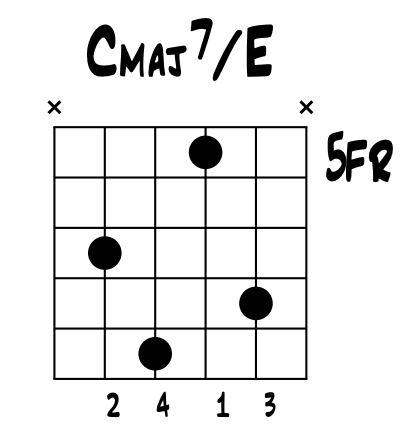
If you repeat this process, you’ll arrive at the second inversion of this chord: Cmaj7/G.
- Our E will move to G
- Our B will move to C
- Our C will move to E
- Our G will move to B

Let’s do it again to get our 3rd inversion of this chord, which we can spell as a Cmaj7/B.
- Move the G to B
- Move the C to E
- Move the E to G
- Move the B to C
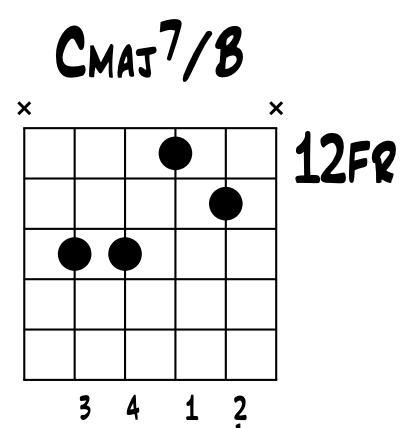
Now you know this 7th chord voicing and all its inversions on this string group! So, what’s next? We need to go through the same process for all the different commonly encountered jazz chord qualities in this string group.
We’ve already covered Cmaj7, so let’s explore C7, Cm7, and Cm7b5. These are the other chord qualities you’ll encounter when playing jazz guitar.
Converting CMaj7 to C7
There are a couple of ways to learn the inversions of the other chord qualities. However, I suggest starting with this one:
Ask yourself, “Which note makes a Cmaj7 different than a C7?”
If you don’t know, there is a way you can use the name of each chord to find out. Cmaj7, as the name implies, is built from a C major triad. This is also the case for a C7. Both of these chords contain a C, an E, and a G.
However, the difference lies in the fourth note. The Cmaj7 has a major 7th interval in it between C and B. A C7 has a minor seventh interval in it between C and Bb.
One way to learn C7 on the same string group as Cmaj7 is to change all the Bs to Bbs. All the other notes are the same. So, if you already know the root position and all the inversions for Cmaj7, you only need to change one note in each to learn C7:

Converting C7 to Cm7
We can continue this process to learn Cm7 on the same string group.
What is the only difference between a C7 and a Cm7? Hint: you only need to change one note to change a C7 into a Cm7.
To convert a C7 into a Cm7, change all the Es to Ebs:

Converting Cm7 to Cm7b5
We need to take our Cm7 chord shapes and change one last note to get our final chord quality. We must flat the 5 (hence the b5) to create this chord. Take every G and make it a Gb:

Jazz Guitar Chords: What’s Next?
If you followed this process, you now know how to play four voicings each for all the essential chord qualities (maj7, 7, m7, m7b5) for C. Where do you take it from here?
Next, you need to play these shapes from every other note so that these shapes are memorized all over the fretboard for every root note past C.
You should also practice these shapes diatonically to practice chord scales for every major key. The following chord scale uses the same root position chord shape and only changes quality depending on the scale degree (I, ii, iii, IV, V, vi, viiø).

Take note: root position 7th chords aren’t as physically practical on the fretboard as other voicings. However, this exercise will help you see how this chord scale sits on the neck.
For an added challenge, try playing the same diatonic chord scale, but keep it in one area of the neck using inversions. This will keep you localized to one area and test your knowledge of the different shapes.
There are many variations of this exercise. However, here is one example using chord shapes from the list above:

While getting comfortable with this, you’ll also want to practice applying these voicings and inversions to actual chord progression found in jazz standards.
For example, here are the first 8 bars of the jazz standard “All the Things You Are,” using some of the shapes and chord inversions from above:
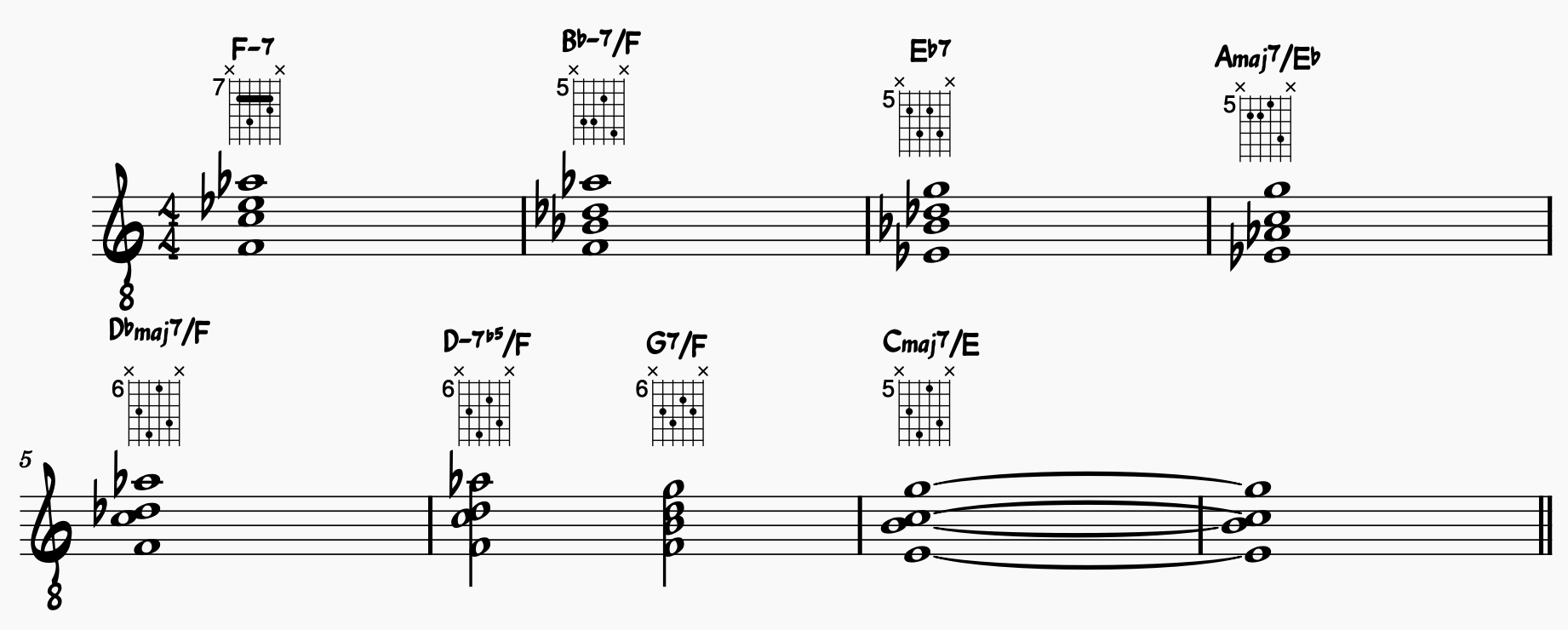
The Inner Circle’s Jazz Guitar Accelerator Course is designed to help you master the fretboard. If you want to master 7th chord inversions and build up your jazz guitar chops, then you need to check out the Inner Circle.
Adding Jazz Rhythms To Your Chord Comping:
You most likely don’t want to play whole notes for each measure when comping in the rhythm section. The best way to internalize the nuances of jazz guitar rhythm is to listen to the players you want to sound like.
The way George Benson might comp rhythm on a blues will be quite different from how Charlie Christian, Wes Montgomery, Pat Metheny, Jim Hall, or Mike Stern might comp one. And those are just some famous jazz guitarists. You also can (and should) take comping inspiration from jazz pianists as well.
There is also the question of which jazz style you should try to emulate and internalize. There are various modern jazz styles, and then there is the long and historied progression of traditional jazz guitar.
Here are some rhythms to get you started when comping over changes (we’ll use All the Things You Are Again). Be sure to set a metronome on beats 2 and 4 to help you feel the swing beat:
1. One Measure Rhythm: Basic Beat 3 Anticipation

2. One Measure Rhythm: 8th Note Comping

3. Rhythm Combination:

4. Two Measure Rhythm: Anticipating the Next Chord

Jazz improvisation is more than just solos. There are rhythmic and harmonic improvisational concepts to consider as well. Strong jazz guitar comping is heavily improvisational! Check out this post to learn some practical exercises to improve your time feel and rhythmic precision.
And, if you want to dig more into chords, check out 20 jazz guitar chords you need to know.
BEFORE YOU CONTINUE...
If you struggle to learn jazz standards by ear, memorize them, and not get lost in the song form, then our free guide will completely change the way you learn tunes forever.

Jazz Guitar Scales Crash Course (Quick Jazz Guitar Lesson #2)
There are several scales jazz guitarists should know. But, more importantly, jazz guitarists need to understand the relationship between scales, chords, and keys. Understanding how scales and chords relate to one another in different keys will help you supercharge your jazz guitar improvisation skills, which we will cover in the next section.
The Modes of the Major Scale (Learn this First!)
If you don’t understand modes, then you should take some time to learn more about them. Check out our post on understanding musical modes for more information. However, a brief rundown will get you thinking the right way about them.
Here are diatonic (meaning from one key) triads (meaning three-note chords) in the key of C major:

When I color code the root, 3rd, and 5th of each diatonic triad, you might notice something familiar about the position of these chord tones as you move from C to Dm to Em, and so on.

- The notes in red start on C and end on C: [C-D-E-F-G-A-B-C].
- The notes in blue start on E and end on E. The blue notes are in the same sequence as the red ones, but they start at a different point going from E to E: [E-F-G-A-B-C-D-E].
- The notes in green start on G and end on G. Like the notes in blue and red, they are in the same sequence but start on a different note in that sequence: [G-A-B-C-D-E-F-G].
So, hidden within the key of C major, there are seven scales. Each one of these scales starts on a different note in C major.
That explains modes theoretically, but what’s the best way to learn them on the guitar?
That gives us seven modes of the major scale, or seven different scales we can play when we encounter different chords in a song:
- C Ionian (C major) [C-D-E-F-G-A-B-C]
- D Dorian [D-E-F-G-A-B-C-D]
- E Phrygian [E-F-G-A-B-C-D-E]
- F Lydian [F-G-A-B-C-D-E-F]
- G Mixolydian [G-A-B-C-D-E-F-G]
- A Aeolian (A natural minor) [A-B-C-D-E-F-G-A]
- B Locrian [B-C-D-E-F-G-A-B]
The following guitar scale diagrams show you all seven modes of C major in two octaves, starting on the big E string. Here are two things to keep in mind:
- The lowest C we can play on the low E string starts on the 8th fret, so we begin the sequence there.
- These are isolated scale shapes. You can access multiple modes from a single position on the guitar, depending on which finger you start with and which scale pattern you choose.
C Ionian (Relates to the I Chord)

D Dorian (Relates to the ii chord)

E Phrygian (Relates to the iii chord)

F Lydian (Relates to the IV Chord)

G Mixolydian (Relates to the V chord)

A Aeolian (Relates to the vi chord)

B Locrian (Relates to the viiø Chord)

If you want a comprehensive breakdown of modes and how to apply them to the fretboard, then check out the Inner Circle’s Jazz Guitar Accelerator Course. It’s designed to give you everything you need to master the fretboard.
Jazz Improvisation: The Fundamentals
If you’ve ever taken jazz guitar lessons, you’ll know there is a strong emphasis on improvisation. Now that we’ve covered chords and scales, we can discuss how to approach the infamous jazz guitar solo.
Experienced jazz guitarists make it seem like magic, but there are fundamental rules that all jazz players follow to play convincing solos. When practicing improvisation, you want to be sure to do the following to make sure your solos are strong:
- Outlining the Changes With Chord Tones
- Using Scale Maps To Apply Specific Scales to Chord Changes
- Learn Jazz Licks (By Ear) and Apply Them
Outlining the Changes By Playing Chord Tones
There isn’t a shortcut to playing over chord changes, but there are ways to optimize your practice sessions so you aren’t wasting time.
The important chord tones that distinguish one chord quality from another are the 3rd and 7th. The 3rd determines whether or not the chord is major or minor, and the 7th determines whether or not the chord is a dominant, minor seventh, or major seventh chord. Though the root and 5th matter, they are less important than the 3rd and the 7th.
The following example is not intended to be a “solo.”
Rather, it is an exercise to get your brain thinking about chord tones as you play in time. As before, we are using “All the Things You Are” for the harmony. Try this with a backing track and a metronome on beats 2 and 4.

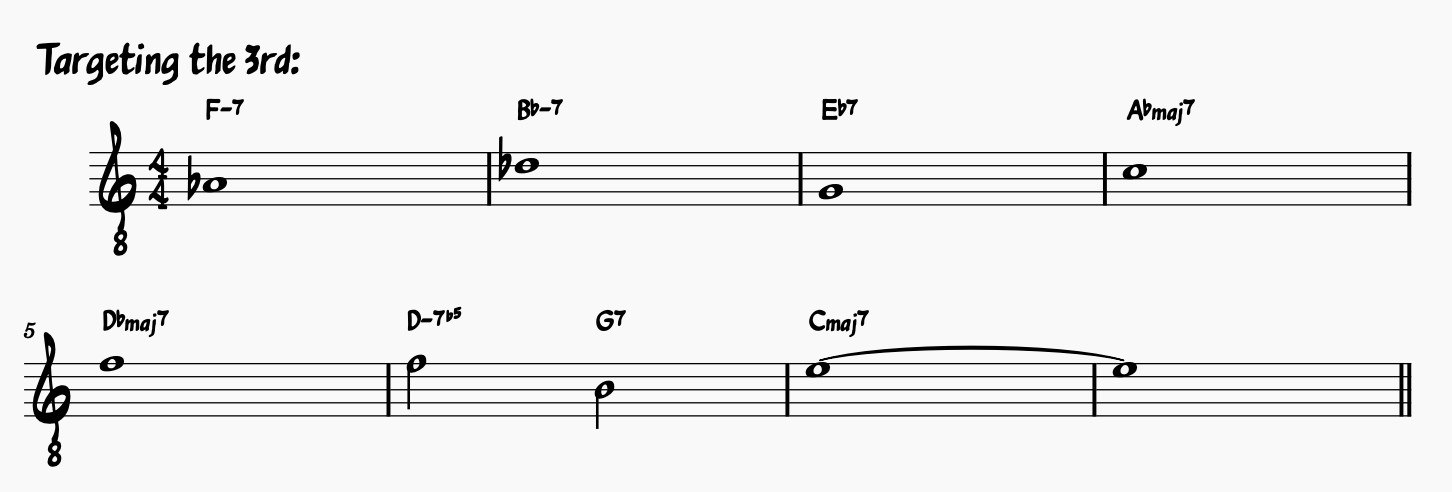

Moving to 7th Chord Arpeggios (adding in the root and 5th)
Notice how this will start to sound more like a solo as the voice leading between notes moves in 3rds:
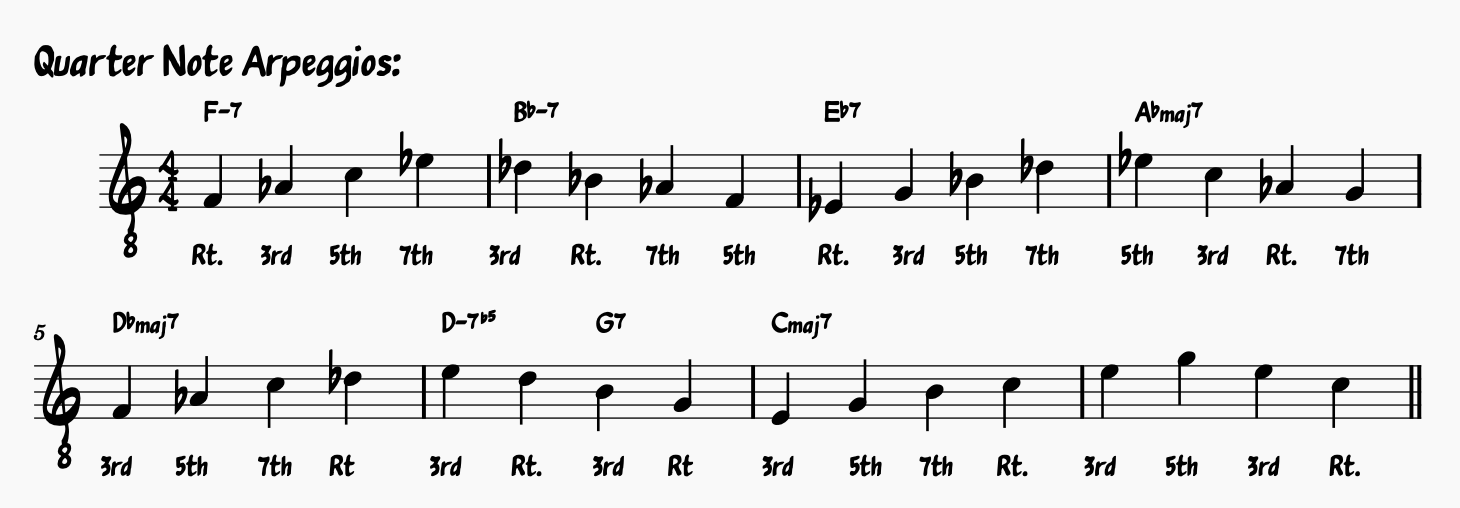
Using Scale Maps To Apply Specific Scales to Chord Changes
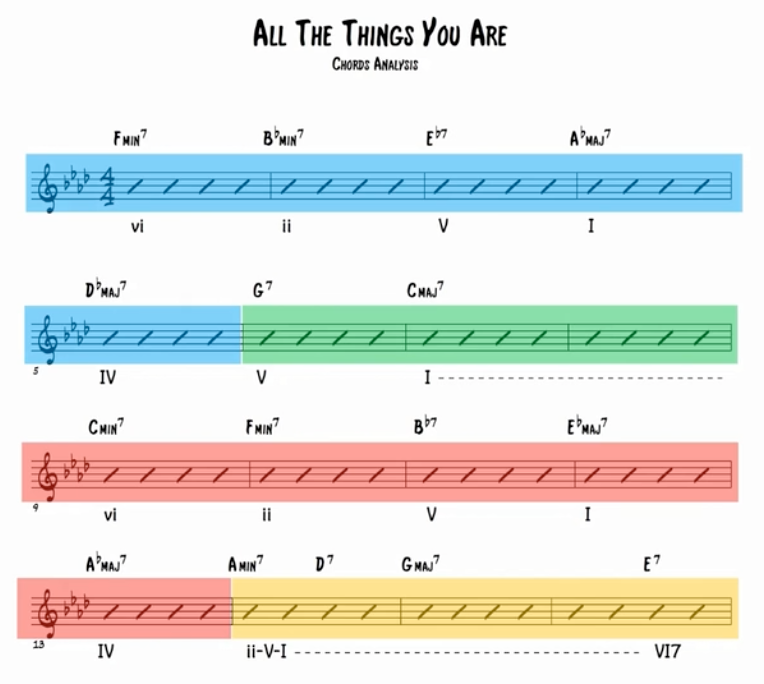
Another way to approach improvisation is to think about the tonal centers of a tune rather than the individual chords. This helps you chunk together how a tune changes as you move through the form. For example, you’ll encounter four different keys or tonal centers in the first 16 bars of All the Things You Are.
- Blue: Ab
- Green: Cmaj
- Red: Eb
- Yellow: Gmaj
When you think of it this way, you can plug in the appropriate modes of the major scale for each key into each section.
Here are the first 8 bars with the appropriate modes plugged in (notice we will play through two key centers: Ab and C):

The Inner Circle’s Jazz Standards Club has detailed scale maps for many of your favorite jazz standards, with a new standard added each month!
Learn Jazz Licks (By Ear) and Apply Them
Though you must practice playing chord tones, arpeggios, and scales over various jazz tunes, if you only focus on this, your solo playing will sound like an exercise. Though jazz guitar solos are made of chord tones, scales, and arpeggios, there is much more to the jazz language than those constituent parts.
You should listen to various versions of All the Things You Are and learn how other players have approached the changes. You can also take pieces from solos over different tunes and plug them into your solo. As long as the musical context is the same (the same chord progression), this will be sure to work.
Here is a video to get you started with playing over the ii-V-I chord progression.
Here are four lines to play over All the Things You Are.
Jazz Guitar Chord Melodies—The Next Step!
Another staple of jazz guitar is the chord melody. Playing a chord melody on guitar requires that you know a few things:
- You know the melody inside and out (you know it in many different positions and on different string groups
- You are familiar with many triad and seventh-chord voicings and inversions, allowing you to effortlessly support the melody with harmony.
- You’ve practiced playing different voices simultaneously on the guitar (in order to play the melody while also playing a bass line or counter-melody).
For more on how to play chord melodies, check out our article on how to play a chord melody in three steps.
The 3 Most Important Things To Keep In Mind When Learning Jazz Guitar (The Best Jazz Guitar Mindset)
You can do several things to cultivate a healthy jazz mindset, which is important to maintain when approaching any task or challenge that requires time, patience, hard work, and trust. The following tips will help you keep positive and on the right track!
1. You Need Exposure To Jazz Guitarists To Find Your Jazz Guitar Sound
You should know the following guitarists, but the list is far from complete. There are many, many other influential jazz players you should check out to help cultivate your jazz sound.
Swing and Early Bebop Guitarists:
- Charlie Christian: Check out “The Genius of the Electric Guitar.”
- Freddie Green: Check out “Count Basie Swings, Joe Williams Sings with Joe Williams” and “April in Paris.”
Hard Bop and Cool Jazz:
- Jim Hall: Check out “Concierto” and “Undercurrent” with Bill Evans.
- Grant Green: Check out “Idle Moments” and “Matador.”
- Kenny Burrell: Check out “Midnight Blue.”
- Wes Montgomery: Check out “The Incredible Jazz Guitar of Wes Montgomery” and “Smokin’ at the Half Note.”
- Joe Pass: Check out “Virtuoso,” “For Django,” and “The Trio” featuring Oscar Peterson and Niels-Henning Ørsted Pedersen.
Post-Bop and Fusion:
- John Scofield: Check out “A Go Go” and “Still Warm.”
- Pat Metheny: Check out “Offramp,” “Bright Size Life” and “Still Life (Talking).”
- Mike Stern: Check out “Upside Downside” and “Time in Place.”
Modern/Contemporary Jazz:
- Peter Bernstein: Check out “Brain Dance” and “Signs LIVE!”
- Bill Frisell: Check out “Blues Dream,” “Gone, Just Like a Train,” and “Good Dog, Happy Man.”
- Kurt Rosenwinkel: Check out “The Next Step” and “Deep Song.”
2. You Need Exposure To Jazz Musicians
In order to stay connected with jazz and motivated to study it, you’ll need to surround yourself with people who love the music as much as you do. There are a few ways to do this, and each has additional benefits:
- Going To Jam Sessions: This will help connect you to your local jazz scene and help you network with other local musicians in your area. Plus, jam sessions are a great way to apply what you’ve been shedding in the practice room.
- Taking Jazz Guitar Lessons (In Person if Possible): Having a music mentor who knows your instrument is a powerful thing. Not only can a jazz guitar teacher help you improve your chops, play jazz guitar, and expand your theoretical understanding of jazz, but they are reservoirs of practical advice. Also, try to take lessons in person if possible. Taking lessons for jazz guitar online is not as powerful as playing with an experienced guitarist in person.
- Taking Jazz Lessons With Other Instrumentalists (In Person if Possible): Don’t limit yourself to only taking lessons with jazz guitarists. Take lessons with jazz drummers, bassists, horn players, and pianists to learn how best to play with and accompany those instruments.
- Playing Jazz With Other Jazz Musicians is KEY: While playing in the practice room is a vital part of learning jazz, the more important part is playing with others. That’s where you’ll learn how to communicate effectively as a musician.
3. You Need Patience and A Love Of Learning
The most valuable advice I received while studying jazz was to trust the learning process. If you earnestly follow the steps laid out by jazz educators, you will see improvement. Your knowledge will expand, and your chops will get better. It requires time and daily effort, but the process works.
You can’t fail if you cultivate a love of learning. If you love learning, you’ll always be hungry to learn more. And trust me, there is always more to learn.
The Learn Jazz Standards Inner Circle Can Help You Accelerate Your Jazz Guitar Playing
If you found this article helpful and want more, then you need to check out the Inner Circle. Our Jazz Guitar Accelerator Course will help you master the fretboard and improve your jazz guitar playing. There are also courses for other instruments, too!
Take the next steps toward becoming the jazz guitar player you want to be—Check out the Inner Circle and trust the process.











